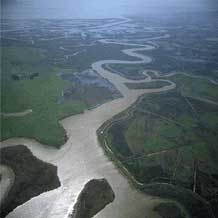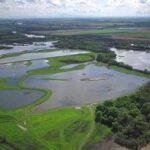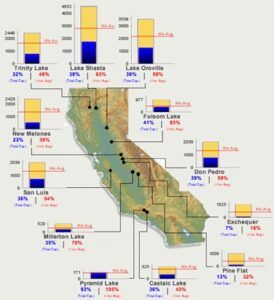South Delta Improvement Program
 In August of 2000, after years of deliberations,
In August of 2000, after years of deliberations,
hundreds of public meetings and development of a full-blown
environmental impact statement, the state-federal
partnership known as CalFed issued an 846-page Programmatic
Record of Decision. This document, a detailed long-term
plan for managing California’s water resources and restoring
its environment, included a series of proposed actions
called the South Delta Improvement Program, or SDIP.
The key elements of the SDIP are:
- Increase pumping capacity of the State Water Project
to 8,500 cubic feet per second; - Install improved fish screens at the Clifton Court Forebay
and Tracy pumping facilities to provide increased protection
for fish; - Install operable barriers to improve water quality and
ensure reliable water supplies for San Joaquin Valley farms; - Construct floodway improvements on the lower San Joaquin
River to provide conveyance, flood control and ecosystem
benefits; - Reduce agricultural drainage in the Delta.
The California Department of Water
Resources (DWR) is scheduled to release a draft
Environmental Impact Report/Environmental Impact Statement
for the SDIP this fall, a step that will begin a new public
review of this program.
The objectives of the SDIP program are:
1) minimize the straying of San Joaquin salmon into the
south delta; 2) maintain adequate water levels and quality
for local farmers; and 3) provide flexibility in meeting
fish, wildlife and water supply needs.
Increasing the capacity of export pumps
(from a current 6,500 cfs flow) will provide significantly
more flexibility for water project and fishery managers.
Export pumping is frequently curtailed when endangered fish
are in the vicinity of the pumps. These curtailments
sharply reduce water supplies for farmers and cities that
depend on the exported water. Currently, the limited
pumping capacity means it is often difficult, if not
impossible, to recover the lost water once the fish move out
of the vicinity of the pumps.
By increasing the capacity of the
pumps, water now lost when pumping is curtailed can be
recovered when the fish move on and pumping poses no threat
to endangered species. Fully operating to the higher
pumping limit would not begin until 2009, after new
permanent operable gates are constructed and operating.
Because of hydrologic and environmental
constraints, the increased pumping capacity is expected to
increase annual water exports between one percent and three
percent over current levels.
Recent indications of population
declines by some fish species that live in the delta year
round have prompted formation of a task force of state and
federal fishery managers to identify what is causing the
declines. A careful review of decades of data indicates
water exports do not play a role in the relative abundance
of these impacted fish species. More likely causes of the
drop in the number of delta smelt are sharp declines in a
species of zooplankton that are an essential food source for
delta smelt.
While this important investigation
continues, DWR plans to release the draft EIR/S for the SDIP
this fall for a 90-day public review period of statewide
workshops. In this way, the draft EIR/S can serve as a
focus for very public discussions of the best ways to
protect and restore fish populations in conjunction with
operating the State Water Project to maintain reliable water
supplies. This public participation is vital to the
decision-making process and the eventual implementation of
any plan.


